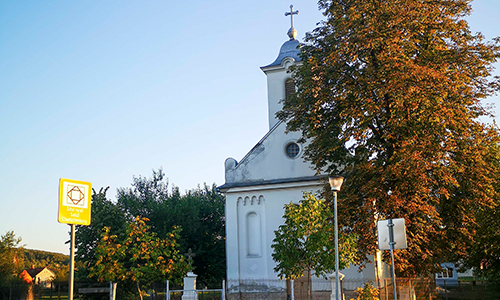Timis County Council, Romania
A dynamic, multicultural, modern and innovative city that keeps alive the memory of past times through a rich historical, architectural and cultural heritage.
Region: Timis
- MULTICULTURAL AND MULTIETHNIC
- INNOVATIVE
- DYNAMIC
Type of organisation leading the larger local innovation ecosystem
Public authority
Timis County Council provides annual funding to cultural institutions and the associative environment in the field through the Cultural Agenda Program of Timis County, which manages to be one of the main ways to support culture, thus contributing to the development of cultural tourism in the county.
Current strategic planning
The strategy for tourism development in Timis County (2018 – 2028) also includes proposals and measures for the development of cultural tourism. Most of the actions undertaken so far in terms of cultural tourism are the creation and promotion of cultural routes on topics related to specific architecture, traditional and ethnic culture; the organisation events to promote the built heritage, to promote the traditions and customs of different ethnic groups in the area or to promote local gastronomy; the involvement and support of the cultural program Timisoara European Capital of Culture in 2023. The most important cultural tourism objectives are:
- Cultural heritage (tangible and intangible) is protected, capitalised, and promoted sustainably.
- Recognised tourist destination for cultural tourism with high-quality services for tourists.
- Increased cultural vitality, supported by a cultural offer adapted to various categories of the local and external public (including support for creative cultural industries).
For Timis County, Circular Cultural Tourism is a new way to increase the notoriety of the destination in a sustainable manner.
Main challenges related to cultural tourism
The main territorial challenges faced by the cultural tourism sector in the region are the concentration of touristic flows in only one site, the accessibility of remote areas and the lack of communication and synergetic actions.
Ideas and future perspectives
Timis Circular Valley – developing a cluster in the circular economy;
Raising public awareness of the importance of using organic, recycled and reused products;
Development of a platform for the promotion and implementation of the circular economy in Timis County;
Incentive program for tourist consumption by offering one night of free accommodation for two nights of accommodation booked by visitors;
Program for recognizing the quality and sustainability of tourism services/products (pilot action for accommodation or food units that includes certification actions for local operators; dedicated training and promotion);
Support for stimulating partnerships in order to capitalize on local resources (e.g. facilitating the interaction between local agricultural producers and accommodation/food units).
Cultural heritage asset description
The Charlottenburg village and its surroundings
The village of Charlottenburg was founded in 1771 by 32 families (171 settlers) who immigrated from Baden-Württemberg, German-speaking Lorraine (Grand East region of France, nowadays) and the German-speaking area of Trentino (Trentino-South Tyrol region of Italy).
The multicultural character of the settlement was a constant feature until the end of the communist regime in Romania, when the German and Hungarian language populations migrated massively. Although currently, the population of the settlement is almost 100% Romanian, the cultural heritage of the settlement is preserved, primarily due to the integral protection (by law) of the settlement as a monument of national and universal value.
Type of cultural heritage
- RURAL
Specific goal related to the selected asset
The multi and interethnic character of Timiș County resides in all the categories of components of its cultural heritage. This fact can and must bring a plus for all the organised actions that shed light and bring to the knowledge of the consumer the patrimony at his disposal. The main goal is to inform the public about the tourism potential of the region.
Europeanisation: linkages between local heritage and European history and culture
Timiș County presents itself today as dynamic, multicultural, modern and innovative, keeping alive the memory of past times through a rich historical, architectural and cultural heritage. These attributes of the county are closely related to the history and civilization of the Banat region.
The multi and interethnic character of Timiș County resides in all the categories of components of its cultural heritage. This fact can and must bring a plus for all the actions that are organized and that shed light and bring to the knowledge of the consumer the patrimony at his disposal.
European and international Cultural Heritage recognition(s)
Even if registered on the national list of sites and monuments, Charlottenburg village still lacks international recognition, but it could be a great candidate for a European Heritage Label because of its unique circular shape and its history defined by a Pan-European identity.
Ongoing projects and best practices
- Timiș County Council is an associate member of the DKMT Euroregional Agency (Danube-Criş-Mureş-Tisa).
- Timiș County Council has developed a series of projects on the restoration and enhancement of heritage elements, by accessing European funds.
- Rehabilitation and revitalisation of fortress of Timisoara Citadelle, Theresia Bastion (link)
- Capitalisation of the cross border tourist potential, including bicycle lane along Bega river, downstream Timisoara (ROMANIA-SERBIA) Main results: Bicycle lane built (Romania); e (link)
- Banatian Village Living Museum, Csongrád – Timiș Tradition and Multiculturality – LIVMUSECSOTM (ROMANIA – HUNGARY Cross-border. (link)
- Renewable Energy Regions Network - REN REN (INTERREG IV) (link)
- The repairing of the navigable infrastructure on Bega Canal (link)
- Eco Tamis (Interreg IPA CBC Romania-Serbia), a tourism infrastructure has been developed that promotes eco-tourism and cycling tourism along several routes (link)


